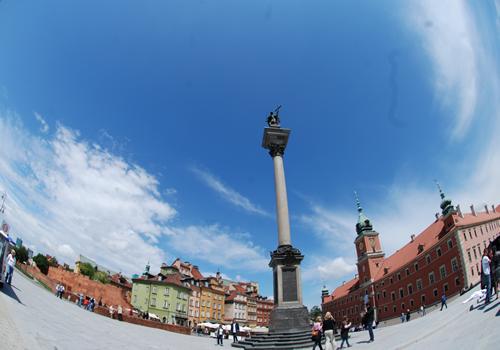|
On a High

Photograph
by Preeti Verma Lal
“Eskalopki cielece w pomidorach a la toklas? Modzek po polsku?” The man in a snazzy suit, moussed pony tail was taking dinner orders crisply with a fountain pen. I was hungry in Warsaw’s hippest restaurant, U Kucharzy, but the dish name seemed too daunting. I fumbled with eskalopski… Was it a broth? A doughnut? A pate? What? Everything was getting lost without translation. In the clamour of what was once the staid kitchen of Hotel Europejski and the forgotten hunting ground of communists, gangsters and escorts, everything is open – you can see the chefs rustling up pig’s knuckle in cognac pepper sauce, cooking the Polish pate and listing table reservation on a computer without a casing. Everything open, you see! There are no waiters in the white-tiled restaurant; cooks trundle their woks and knives and standing by you mince the meat, beat the egg yolk into it and lo! the steak tartare gets ready before you can repeat eskalopki cielece…. The vegetarian in me baulked at the colossal roasted pig legs being snipped off the bones and slathered with horseradish sauce. My stomach was growling but I knew not what to eat. Till the moussed man reluctantly agreed to dress up a salad and sauté some vegetables. “Without wine”, I insisted. The moussed man’s jaw fell – in an alcohol/meat eatery, I, the vegetarian/teetotaler was oddly placed. In Poland, men order 5 litres of Tyskie, the Polish ale, I was downing my salad with still, chilled water. That was the beginning in Warsaw.
That, however, was not the last time heard I heard of Polish ale. Of alcohol, actually. Warsaw was tipsy with freedom; a day after I arrived the nation was to celebrate the 20 th anniversary of the death of communism and Soviet occupation. The Polish capital was wet and nippy, but the geraniums were blooming and the city brimmed with exuberance. I saw the statue of Polish Copernicus who decreed that the world is round, not flat; I moseyed up to streets where Pope John Paul II peered down from every wall (there are 1,400 monuments to the Pope in Warsaw); I walked by a nunnery and the 19 th century vodka factory.
But in Warsaw my search was unusual – I was looking for a vial of cognac that lies buried behind a pillar in the Holy Cross Church. Naah! I had not jumped over the fence to Bacchus’ territory, I was looking for the heart of Fredrick Chopin, the composer, whose heart lies preserved in cognac. Chopin who composed the intense Ballade No. 4 in F minor died in Paris in 1849 at age 39. His last wish: His heart be brought back to Warsaw. As I walked up the marble steps of the Church, I could hear the hum of a hymn; in the ornate church Christ stood crucified in a corner and candles were flickering at the altar, but I did not say a prayer. I wanted to hear the heartbeats of a man who composed ballades and nocturnes. On a grey pillar on a white plaque was written: Here lies the heart of Fredrick Chopin. I stood by the wall, waiting for the heartbeat to reverberate; instead I heard the strains of the Ballade No. 4. Maybe Chopin’s heart still beats in that vial of cognac. At least I heard the murmur in F minor.
“Everything in Warsaw is fake,” Piotr Karpinski’s voice boomed. I thought Peter had muddled his facts, but the Indophile tour guide insisted on the ‘fake’. I never question a guide, they always know their facts. He was right. Warsaw was completely destroyed during the Second World War, everything razed to the ground. Only two buildings survived. But when peace returned, the city was built, stone by stone, brick by brick in three years – what you see in Warsaw is a painstaking replication of the world before the bombs fell from the skies during the war. Amidst the chore of recreating an old world, the city did not forget its bravehearts, it built the Monument to the Heroes of the Jewish Ghetto, the Tomb to the Unknown Soldier and Monument to the Katyn Victims.
But the magic lies in the Old Town, a 700-year old settlement that tells its history through the Barbican (city walls), the Royal Castle, St. John’s Cathedral, the Warsaw Mermaid and the tenement houses with vibrant emulsion on their walls. There are quaint eateries and cafes, churches tucked in corners and ice cream parlours interspersed with art galleries. In the midst of ancient history is the yellow house where lived Madame Maria Curie, the first woman to win a Nobel Prize.
Wherever you go in Warsaw, you would find Stalin everywhere. Actually, Stalin’s gift. The beige Palace of Culture, Stalin’s gift to the city, towers over everything. “Isn’t it called Stalin’s nose?” I ask Karpinski. “Call it the Palace of Culture. Let’s not talk and remember Stalin. I feel better without him…” It was the 20 th anniversary of freedom and Karpinski certainly did not want to look back into the era of communism and all its paraphernalia. I paid heed. No Stalin talk in Warsaw.
Warsaw was cold but I borrowed the warmth from freedom’s exuberance. To partake in the joy, I walked into famous Lazienki Park and fed walnuts to finches and warblers. And before night could bring sleep onto my tired eyelids, I ordered a paczki ziemniaczane z kapusta (potato doughnuts stuffed with cabbage). There was no moussed man that night to take the orders – I picked the first one on the menu. In Poland there are 366 cabbage dishes, but I was too weary to run through them all. I would go to Warsaw again. You see, there are 365 of them waiting on the menu. That’s 365 good travel excuses!
Published
in The Indian Express, 2009 |

